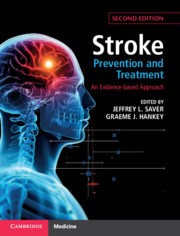Book contents
- Stroke Prevention and Treatment
- Stroke Prevention and Treatment
- Copyright page
- Dedication
- Contents
- Contributors
- Preface
- Part I Foundations
- Part II Systems of Care
- Part III Acute Treatment of Ischaemic Stroke and Transient Ischaemic Attack
- Chapter 5 Supportive Care during Acute Cerebral Ischaemia
- Chapter 6 Reperfusion of Ischaemic Brain by Intravenous Thrombolysis
- Chapter 7 Reperfusion of the Ischaemic Brain by Endovascular Thrombectomy and Thrombolysis
- Chapter 8 Collateral Flow Enhancement: Blood Pressure Lowering and Alteration of Blood Viscosity
- Chapter 9 Acute Antiplatelet Therapy for the Treatment of Ischaemic Stroke and Transient Ischaemic Attack
- Chapter 10 Acute Anticoagulant Therapy for the Treatment of Acute Ischaemic Stroke and Transient Ischaemic Attack
- Chapter 11 Treatment of Brain Oedema
- Chapter 12 Neuroprotection for Acute Brain Ischaemia
- Part IV Acute Treatment of Haemorrhagic Stroke
- Part V Prevention
- Part VI Stroke Rehabilitation and Recovery
- Index
- References
Chapter 10 - Acute Anticoagulant Therapy for the Treatment of Acute Ischaemic Stroke and Transient Ischaemic Attack
from Part III - Acute Treatment of Ischaemic Stroke and Transient Ischaemic Attack
Published online by Cambridge University Press: 15 December 2020
- Stroke Prevention and Treatment
- Stroke Prevention and Treatment
- Copyright page
- Dedication
- Contents
- Contributors
- Preface
- Part I Foundations
- Part II Systems of Care
- Part III Acute Treatment of Ischaemic Stroke and Transient Ischaemic Attack
- Chapter 5 Supportive Care during Acute Cerebral Ischaemia
- Chapter 6 Reperfusion of Ischaemic Brain by Intravenous Thrombolysis
- Chapter 7 Reperfusion of the Ischaemic Brain by Endovascular Thrombectomy and Thrombolysis
- Chapter 8 Collateral Flow Enhancement: Blood Pressure Lowering and Alteration of Blood Viscosity
- Chapter 9 Acute Antiplatelet Therapy for the Treatment of Ischaemic Stroke and Transient Ischaemic Attack
- Chapter 10 Acute Anticoagulant Therapy for the Treatment of Acute Ischaemic Stroke and Transient Ischaemic Attack
- Chapter 11 Treatment of Brain Oedema
- Chapter 12 Neuroprotection for Acute Brain Ischaemia
- Part IV Acute Treatment of Haemorrhagic Stroke
- Part V Prevention
- Part VI Stroke Rehabilitation and Recovery
- Index
- References
Summary
In broad, relatively unselected patients with acute ischaemic stroke, immediate high-dose anticoagulation therapy to avert early stroke progression or recurrence reduces recurrent ischaemic stroke compared with control during the treatment period but this benefit is offset by an increase in intracranial haemorrhage (ICH) and extracranial haemorrhage (ECH). Immediate antiplatelet therapy has similarly efficacy as anticoagulation in averting early stroke progress or recurrence, and is safer when used as an immediate agent (see Chapter 9). In acute ischaemic stroke patients with atrial fibrillation, after start of antiplatelet therapy on presentation, early switchover to anticoagulation therapy 2 -14 days after stroke onset is reasonable, but caution should be taken in certain subgroups of patients with high risk of bleeding. In broad, relatively unselected ischaemic stroke patients, low-dose, venous prophylaxis anticoagulation compared with control reduces the occurrence of asymptomatic deep venous thrombosis (DVT) and shows a tendency to reduce pulmonary embolism, but also shows off-setting tendencies to increase ICH and ECH, without conferring a clear net clinical benefit. Low-molecular-weight heparins (LMWH) or heparinoids, compared with unfractionated heparin, appear to further decrease the occurrence of DVT and PE but potentially further increase ICH, but there are too few data to provide reliable information.
Keywords
- Type
- Chapter
- Information
- Stroke Prevention and TreatmentAn Evidence-based Approach, pp. 179 - 198Publisher: Cambridge University PressPrint publication year: 2020



